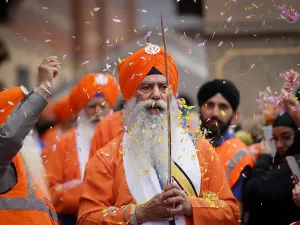
In conversation with Jasvir Singh CBE (Barrister), our guest blogger chatting about Vaisakhi.
Vaisakhi is one of the most important dates in the Sikh calendar. Falling on 14th April each year, it marks the date when the Khalsa Panth or the inner core of the Sikh faith was created
In the late 17th Century, Sikhs were being heavily persecuted in the Mughal Empire. The 9th Sikh Guru had been publicly executed on the streets of Delhi in 1674 for failing to give up his faith and convert, and his young son became the 10th Guru. The new Guru, Guru Gobind Rai, was concerned about how the Sikh community could survive this relentless oppression. He needed to protect his people, but he also wanted to ensure that Sikhs remained proud of their unique identity and heritage.
In Spring 1699, the Guru had commanded that his disciples gather at his home in the foothills of the Himalayas on the day of Vaisakhi, and people from far and wide travelled to be there. The Guru came out of a tent and asked for five Sikhs to come forward and give their heads to him. Some of his followers who had gathered that day went off to find the Guru’s family and tell them that the Guru had gone mad. Others ran for their lives, hoping not to be picked by the Guru. Eventually, five Sikhs went to the Guru and offered to give their lives to him.
When the Guru re-emerged, he brought out the five Sikhs now dressed in identical clothes and revealed that a new group called the Khalsa, or the Order of the Pure Ones, had been founded in the religion. The five Sikhs who had offered to give their lives would from now on be known as the Panj Pyare or Five Beloved Ones.
Men initiated into the Khalsa took on the name ‘Singh’ or ‘lion’, and women became ‘Kaur’ or ‘princess’. All differences would be put aside upon joining the Khalsa, and all would be treated equally. The Khalsa became the inner core of the faith, an order willing to protect and preserve the Sikh tradition, as well as defend the rights of others to practise their own beliefs in peace and harmony. After initiating the first five Khalsa Sikhs, the Guru asked them to initiate him into the Khalsa as well. Gobind Rai became Gobind Singh, and the Guru became known as the Guru-disciple.
Gurdwaras will be busy in the run up to Vaisakhi as well on the weekend of Vaisakhi, and the langar or community kitchens will be feeding worshippers around the clock. Some areas will also see nagar kirtans or processions where the Sikh scriptures or Guru Granth Sahib is taken in a float through the streets accompanied by devotional singing by the congregation following behind. It’s a time of great joy and celebration, but it’s also a time when Sikhs will be thinking about our own turbulent history and the actions taken by Guru Gobind Singh to defend our existence over 300 years ago. But for the Khalsa, the Sikh community simply wouldn’t exist in the present day.






